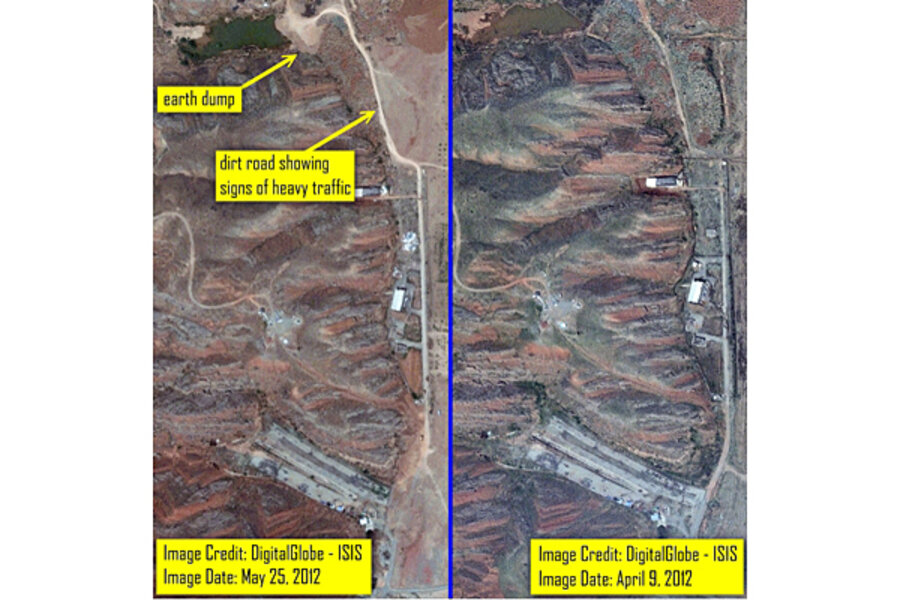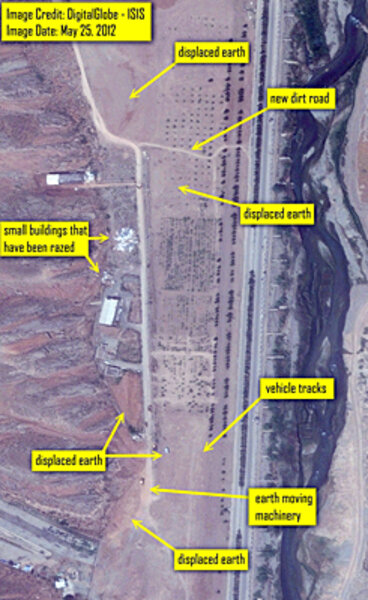Satellite images suggest Iran cleaning up past nuclear weapons-related work
Loading...
| Istanbul, Turkey
Updated at 2:19 p.m. on May 31, 2012.
United Nations weapons inspectors yesterday shared satellite images that suggest Iran may be cleaning up evidence of past nuclear weapons-related work, at a suspect military site inspectors have been seeking to visit.
At a closed-door briefing in Vienna, the deputy head of the International Atomic Energy Agency (IAEA), Herman Nackaerts, showed diplomats several satellite images taken over the past half-year of Iran's sprawling Parchin military complex.
The latest image, dated May 25, showed the apparent destruction of two or possibly three small buildings relatively close to the main structure – which had all been intact in earlier images.
“Iran is worried that the agency might find something there. Otherwise it wouldn’t be going through the sanitization process,” a senior Western official told Reuters.
Similar satellite images were later published by the Institute for Science and International Security (ISIS), a Washington think tank that tracks nuclear developments, and is used by the IAEA as a conduit for making "restricted" reports public.
The latest image appeared to show "further sanitization activity," ISIS said in a brief analysis about the “razed” buildings. "There are visible tracks made by heavy machinery used in the demolition process," and "extensive evidence of earth displacement."
But Olli Heinonen, the IAEA's head of safeguards until two years ago, says it's hard to know for sure the nature of those activities.
"Without having actual access to Parchin, one cannot say much what is really happening there," says Mr. Heinonen, now at Harvard University's Belfer Center for Science and International Affairs in Cambridge, Ma.
"It is important that the IAEA has the access soon to the site to establish facts, but the Agency should, in my view, also think at the same time how to approach such confrontational topics without sacrificing the success of the mission," says Heinonen. "A lower key, less specific request could have perhaps been more beneficial, but the Agency may have had its reasons to proceed this way."
Iran: Western fears 'childish'
Ali Asghar Soltanieh, Iran's representative to the IAEA, has said in the past that Western and IAEA fears about Parchin were "childish" and "ridiculous." After yesterday's presentation in Vienna, Mr. Soltanieh told journalists that "this kind of noise and allegations are baseless," according to Reuters.
The previous two UN inspections to Parchin were both in 2005, though to different buildings, and were led by Heinonen. The IAEA has repeatedly asked this year to visit the military site again, in search of a containment chamber it believes may have been used more than a decade ago for nuclear weapons-related high explosives testing. (Editor's note: A previous version of the story misstated who led the 2005 visits.)
Iran has said it will grant access to Parchin, but only in the context of a framework agreement to resolve all remaining questions about Iran's controversial nuclear program.
IAEA chief Yukiya Amano was on the verge of signing that agreement during a visit to Tehran on May 21. But contentious nuclear talks in Baghdad between Iran and world powers just two days later appear to have delayed the deal.
Increased pressure on Iran to provide access
The head of Iran's nuclear energy agency, Fereydoon Abbasi-Davani – survivor of a November 2010 assassination attempt, of the type which has claimed the lives of five other Iranian scientists – said last week the IAEA had yet to "convince" Iran it had reason enough to visit Parchin.
The new satellite imagery will raise pressure on Iran to provide access, and to explain the situation at Parchin.
The IAEA's most recent quarterly report on Iran, dated May 25, referenced satellite data of Parchin, and noted that "where virtually no activity had been observed for a number of years, the buildings of interest to the Agency are now subject to extensive activities that could hamper the Agency's ability to undertake effective verification."
That IAEA report said more information had been obtained that linked the site to possible past high explosive tests, which it stated in November 2011 would be "strong indicators of possible [nuclear] weapon development."
Razing Parchin prior to IAEA visit?
Last month ISIS published an April 9 image of the site, which appeared to show that streams of water had poured from the building.
Iranian officials at the time dismissed the claims of an attempted clean-up as a "joke." Experts say any past use of nuclear material there would be virtually impossible to hide from IAEA inspectors.
Two smaller structures near the main building were intact in the early April image, but appear to have been broken apart in the new image from May 25. Certain dirt roads in the latest image also seem to have been subject to fresh heavy use.
ISIS in its analysis said the new image "raises concerns that Iran is attempting to raze the site prior to allowing an IAEA visit."
The IAEA has reported that Iran in late 2003 and early 2004 razed a site at Lavisan-Shian, where the Physics Research Center was once located. In subsequent reporting, the IAEA said the center was set up in 1989 as the first of several administrative structures designed to manage “systematic” alleged weapons-related work. The bulk of that work was halted "rather abruptly" by late 2003, though may have continued episodically since then, says the IAEA.







